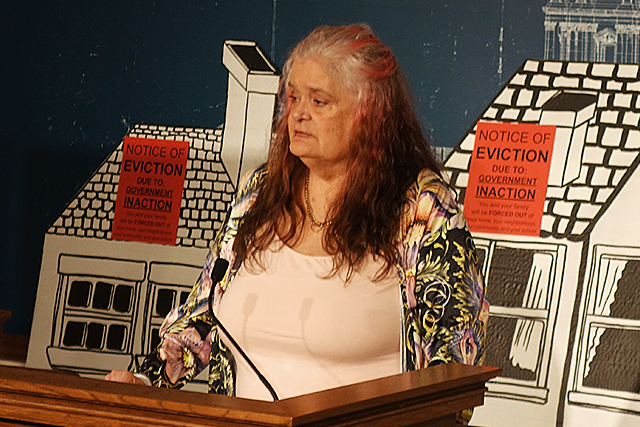In 2020, just as it seemed that the pandemic was going to cause a homelessness crisis, federal, state and city governments stepped in with emergency measures to prevent a startling uptick in people living outside.
Now, with the last eviction guardrail in Minnesota being lifted, and no increase in shelter space — or notable jump in available affordable housing — housing advocates worry the Twin Cities will see what they feared at the onset of the pandemic: a significant rise in the number of people without shelter.

Wendy Underwood, head of the social justice advocacy and engagement team for Catholic Charities of St. Paul and Minneapolis, echoed those concerns. “We are very worried that’s exactly what we are facing,” she said.
A historic level of housing aid
The potential for the homelessness issue to explode was there in March 2020. By the end of that month, there were 6.65 million jobless claims for the week, a record at the time. Come April 2020, the unemployment rate skyrocketed to 14.7 percent and the country lost an estimated 10 million jobs.
All those lost jobs threw millions of Americans into housing instability. But the federal government, via three rounds of economic aid — including the CARES Act and American Rescue Plan Act (ARPA) — sent billions of dollars to state and local governments for emergency housing aid.
In Minnesota, the state also enacted two influential housing measures during the pandemic: an eviction moratorium and rental assistance. Enacted through executive orders by Gov. Tim Walz, the eviction moratorium prevented eviction, lease termination or nonrenewal of a lease other than in a few narrowly defined instances. Meanwhile, the state’s rental assistance program, RentHelpMN, spent more than $450 million of federal money helping Minnesotans who were behind on rent by paying their property owners.
The result: Instead of seeing a rise in the number of unhoused, the Twin Cities saw a level of housing stability it hadn’t experienced in years.

Haven Housing saw the same thing, said Nilsson. “Homelessness actually got better during COVID,” she said. “The reason I say that is because of rental assistance. The vast majority of people who lose their housing, it’s not because they have a drinking problem or they think the FBI is following them. It’s because they can’t pay their rent and something has happened where there is that mismatch. Sometimes they’re drinking up all their rent money. But for the most part, it’s a loss of income. What happened during COVID is that we stopped having as many people coming into shelter because there was rental assistance available.”
Nordick-Stone said that the child tax credits and direct stimulus payments from the federal government were also a big help for those facing housing instability. “When you think of poverty, it’s always said that a couple hundred dollars more a month can make the difference, and these payments proved it,” said Nordick-Stone. “A one-time infusion of cash that paid for two months of rent made all the difference.”
At the same time, when the spread of the virus was at its worst, both Ramsey and Hennepin counties struck deals with hotels so that people in cramped shelters could safely social distance in private hotel rooms. “Giving a person a room key and a door and that sense of privacy and safety knowing that, ‘I can leave my stuff somewhere and it’s gonna be there when I come back.’ That weight off a person’s mind and heart make a real difference for a person, it is a real impact,” said Underwood.
A bridge that’s not there yet
Haven Housing, Catholic Charities, and People Serving People all saw a drop in the number of people accessing their shelters when pandemic aid set in. But they each also started seeing an uptick again when various components of aid started to go away. The eviction moratorium came to an end last fall, and applications for rental assistance were cut off at the end of January. And although those who applied for rental assistance were still protected from eviction while their application was pending, those protections ended on June 1.
Underwood says that even though there is an “all-hands-on-deck” effort to prevent those in temporary shelters from falling back into homelessness, some will. “We have literally lived through the temporary solutions, we just need them to keep going.”
Nilsson said she believes the full effects of the end of pandemic-era housing aid will be seen in about three months, and she emphasized the need for a statewide solution to housing. Haven Housing data shows that one-third of the state’s homeless population is in Minneapolis and St. Paul, a third in the suburbs and a third in greater Minnesota. But in more than 60 of Minnesota’s counties, there are zero shelters, Nilsson said.

Nilsson said she is sensing some agreement among lawmakers in the statehouse on investing in programs for homeownership. But she said many people are not ready — financially or emotionally — to own a home, and many others never want to.
Instead, she believes legislators should invest state money in housing that is deeply affordable, including rental housing, for people who make as low as 10% of the area’s median income (AMI). The 2022 AMI for a family of four in the Twin Cities is $118,200, according to the Met Council. (At this year’s legislative session, House Democrats and Walz proposed spending hundreds of millions on housing, including money for rental assistance and homelessness prevention, but the session adjourned before lawmakers could agree on numerous tax and spending bills, including those that addressed housing policy.)
“Housing takes time, we recognize that there’s about three years between right now and when there will be more housing stock,” said Underwood. “And we recognize there needs to be a bridge to get from now to that housing so we don’t slip backward as a region. We need to be on that bridge today, and it’s not there yet.”


0 Commentaires